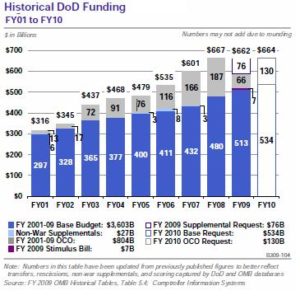This is the third in a series of articles, which predict what will not happen in 2013. This article focuses on why the future may not occur this year, and how it will affect Defense spending.
I am not now, nor have I ever been, a Mayan
Just to be clear, when I say 2013 will not be the year that the future finally arrives, I am not predicting some kind of apocalypse. In this context, I am talking about attributes we commonly associate with the future, such as innovation, progress, and improvements in technology as well as the standard of living.
In some ways this assertion is strongly counter-intuitive. After all, you may be reading this article on a handheld electronic device that received it at the speed of light over a wireless data system. Besides, didn’t you see that net-enabled fork at the Consumer Electronic Show? How can we say the future isn’t happening?
Nevertheless, there are a surprisingly large number of experts who are questioning our traditional assumptions of progress.
Yes, but it will be a great aircraft
Let’s take look at the Defense sector, which traditionally has taken the point in technological innovations. In fact, US military doctrine is to maintain a strategic advantage specifically through superior technology. The cost of that advantage is becoming ruinous.
In 1983, Norman Augustine, an aerospace authority, observed the exponential growth of combat aircraft since 1910. He famously concluded:
“In the year 2054, the entire defense spending budget will purchase just one aircraft. This aircraft will have to be shared by the Air Force and Navy 3½ days each per week except for leap year, when it will be made available to the Marines for the extra day.”
It is depressing that 30 years later, the so-called Augustine’s law of ever-increasing Defense expenditures has proven to be as reliable as Moore’s law about the doubling of transistors on integrated circuits every two years.
Source: Economist
Augustine argued that his law applies to other weapon systems as well. This out-of-control spending has impacted the Defense spending budget. Take a look at the numbers for the first 10 years of this century.
Source: DoD FY 2010 Budget Request Summary Justification
While higher manpower costs and foreign wars have contributed to the increased expenses, acquisition of advanced technology has clearly played a role. Government Accountability Office (GAO) reports that the cost of 96 of America’s biggest weapons programs in 2008 rose on average by 25%, incurring an average delay of 22 months.
Weapon systems that go over budget, miss deadlines, produce fewer functional units, and deliver fewer capabilities than initially promised are the rule not the exception. Some are even arguing that the capabilities of the Defense forces as a whole are actually declining.
The Department of Defense (DoD) has been fully aware of this problem and has made numerous efforts to enact acquisition reform. Despite touted successes, procurement remains a serious problem. Why are we getting less bang for a lot more bucks?
I have seen the future and we can’t afford it
An article in the Economist argues that our reliance on technology is partially at fault. They refer to Philip Pugh, author of “The Cost of Seapower,” a 1986 study of shipbuilding. He maintains that rapid technological change has created an exorbitant race for the latest, the biggest, and the best. In recent years, we have increasingly relied on a technological edge as a “force multiplier,” i.e. to offset manpower costs. According to Pugh, this trend is actually more pronounced in peacetime. During war, quantity becomes more important than quality.
Is it possible that we have reach some kind of tipping point in which the absolute best technology has become so expensive that its costs have eliminated its strategic advantage? Could it be that the not-so-great system is actually preferable? Will we see pompous politicians standing before TV cameras loudly declaring that “Our fighting forces deserve the second best”?
The above scenario may not be as absurd as it sounds. Augustine formulated another law that stated that “…the last 10% of performance generates one-third of the cost and two-thirds of the problems.” Former NASA administrator, Daniel S. Goldin, pioneered the controversial “faster, better, cheaper” approach that specifically avoided this last 10%. He even argued that a 100% success rate of certain projects was a sign of playing it “too safe.” The so-called “90% solution” has been advocated by some within the military, as a way of accelerating the adoption of innovations.
The death of innovation
The problem may not lie entirely in the much maligned acquisition practices of the DoD. Some prominently placed experts have been bemoaning the lack of innovations in the civilian sector as well. No less a personage than Peter Thiel, a founder of PayPal, says that innovation in America is “somewhere between dire straits and dead.” A growing number of economists argue that the world has reached a technological plateau.
To be honest, I don’t completely understand the reasoning behind this line of thinking. (you can read about it for yourself here and here). As best that I can figure, it boils down to two concepts:
1) Innovation itself is stagnating. The percentage of the American economy dedicated to R&D has grown by a third since 1975, but Pierre Azoulay of MIT and Benjamin Jones of Northwestern University claim that researchers are less effective than they were in the past. On average, a 1950s era R&D worker had almost seven times more “total factor productivity” than a worker in 2000. As technical fields grow in depth and complexity, the “burden of knowledge” makes further innovations more difficult.
The modern kitchen is an illustration of the death of innovation. With its microwaves, dishwashers, electric refrigerator, the 1979 kitchen was radically different than its counterpart in 1909. Yet, a typical 2012 kitchen is fundamentally the same as the one in 1979.
2) New innovations are having less economic effect. Technological advances in the 1800s and early 20th century had a much greater impact than current one. For example, the spread of electrification led to greater increases in the standard of living than the rise of personal computing did.
As evidence for this idea, economists point to the growth rates of the developing world. Countries that are now adopting the same technologies that we did a hundred years ago (such as electrification) are experiencing a far greater economic boom than developed countries are.
Another example is life expectancy. From the beginning of the 20th century to 1980, life expectancy at birth in America increased 25 years. Yet, since 1980 until now it has just increased just 4.7 years. Contemporary technological advances simply haven’t had the same impact as those in the past.
In spite of its impressive academic pedigree, it’s hard to give any credence to the “death of innovation.” Take the example of the kitchen. As Matthew Yglesias points out in Slate’s Money Box, the lack of changes in the modern kitchen is not the result of insufficient technological innovation. A quick glance at a cable-channel cooking show will reveal all kinds of modern gizmos. Economic stagnation of the middle class is why kitchens have not changed much since the 1970s. Reduced innovation is not driving slow economic growth, but rather slow economic growth is driving a lack of adoption of innovations.
Indeed, our era is characterized by an extraordinary amount of rapid change. The inability to keep up with constant state of innovation is stressing virtually every institution in the world, including the DoD. Weapon systems are obsolete before they are completed. End-of-life issues for COTS equipment are making repairs expensive. Integration of the latest components with legacy technology is a widespread challenge.
AMREL’s Vice President of Business Development, Richard Lane describes the challenge posed by constant change. He says, “The impact of Innovation is lost in the Defense Acquisition process. As a 2nd tier contractor I must pay for the absolute best technology today – but it won’t be delivered until tomorrow….at which time it is obsolete. And I have to make a profitable business on this model.”
It is the problems caused by innovation that may validate one of the assertions of technological pessimists; the benefits of change were greater in the past than they are now. In our search for the “next big thing,” we as a culture may be wildly overestimating the advantages of progress. The cost/benefit ratio of innovation may have shifted.
In this context, the morass of the Defense acquisition makes a little more sense. The race for the superior technological edge is just a variation of “generals always fight the last war.” We are seeking game-changing innovations, because that is what worked in the past. However, according to these pessimistic economists, disruptive technologies may lack the impact they once had.
Where good ideas come from
The decreasing productivity of research workers, as described above, may be significant, but not for the reasons the technological pessimists maintain. Steve Johnson in his book, “Where Good Ideas Come From: The Natural History of Innovation,” outlines several conditions necessary for the creation of ground-breaking concepts. One of the conditions is “liquid networking,” i.e. an effective system of communicating numerous ideas in an atmosphere of free exchange.
So important is “liquid networking” that it may actually supersede the profit motive as a driver of innovation. Johnson laboriously lists all the technological advances since the Middle Ages, and classifies them as to whether they are profit or non-profit-driven, and whether they were developed in a proprietary, secretive fashion, or in an open, public way. Both in number and quality, far more innovations have been developed the non-proprietary, open, free-exchange settings.
Research and Development may be becoming less productive, not in spite of the private money being poured into it, but precisely because it is in the private sector, which tends to restrict the flow of information. In some ways, this is not a big surprise. Virtually every major profit-driven corporation has a relationship with at least one research center at a non-profit university. It isn’t an accident that Silicon Valley is near Stanford and the University of California at Berkeley.
The lack of public networking for technological development clarifies why DoD acquisitions are problematic. Defense vendors are notoriously protective of their proprietary technology. Every sales meeting begins with signing of Non Disclosure Agreements. For the DoD to use private companies to acquire the latest technological advances is like hammering a nail with a screwdriver. Yeah, you can do it, but it’s the wrong tool.
Obviously, I am greatly simplifying the situation. DoD invests a lot of money in university research. Johnson, himself, describes how secretive companies, such as Apple, are able to employ liquid networks (click here to read a summary of Johnson’s ideas).
It is safe to assume that at least some of DoD’s acquisition problems are due to inefficiencies caused by restrictive attitudes about proprietary technology. Clearly, we must continue to protect intellectual property. However, as Defense vendors, we should remember that there are times that cooperation can be as important as competition in delivering a superior product. To maximize the benefits of innovations, we need to establish a new paradigm that simultaneously guards proprietary technology, while exploiting the benefits of open networks.
Summary
- The resources required to develop and deploy Defense systems that incorporate the latest advanced technology are increasing at a ruinous rate.
- The costs of a constant state of innovation may be increasing, while the benefits of new technologies may be decreasing.
- An atmosphere of open, free-exchange is the most efficient setting for developing new technologies.
- Part of DoD’s acquisition problems are due to Research and Development being conducted in closed, profit-driven settings.
- To encourage an efficient development and deployment of innovations, proprietary technology must be protected, while cooperation and free exchange of ideas are enhanced.










